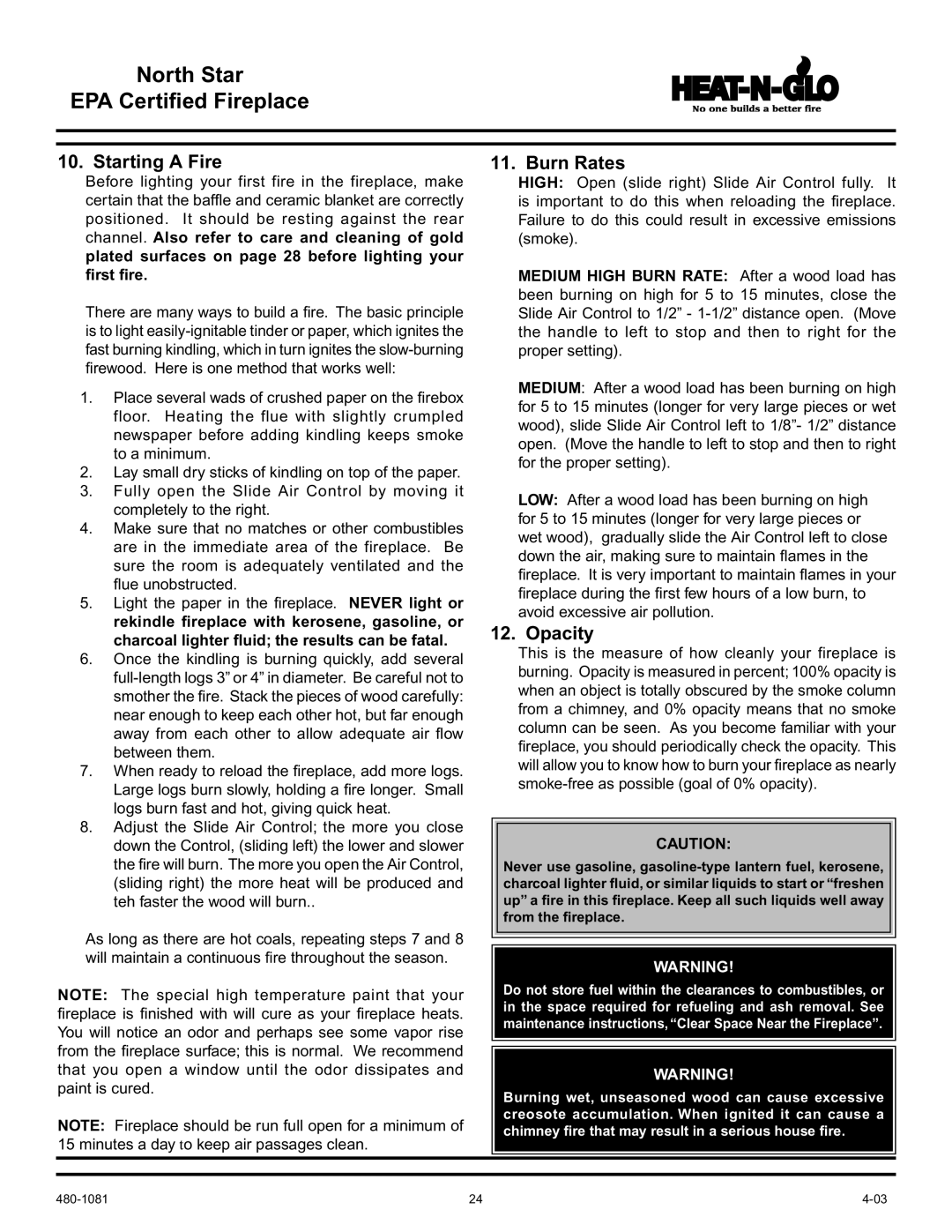
North Star
EPA Certified Fireplace
10. Starting A Fire
Before lighting your first fire in the fireplace, make certain that the baffle and ceramic blanket are correctly positioned. It should be resting against the rear channel. Also refer to care and cleaning of gold plated surfaces on page 28 before lighting your first fire.
There are many ways to build a fire. The basic principle is to light
1.Place several wads of crushed paper on the firebox floor. Heating the flue with slightly crumpled newspaper before adding kindling keeps smoke to a minimum.
2.Lay small dry sticks of kindling on top of the paper.
3.Fully open the Slide Air Control by moving it completely to the right.
4.Make sure that no matches or other combustibles are in the immediate area of the fireplace. Be sure the room is adequately ventilated and the flue unobstructed.
5.Light the paper in the fireplace. NEVER light or rekindle fireplace with kerosene, gasoline, or charcoal lighter fluid; the results can be fatal.
6.Once the kindling is burning quickly, add several
7.When ready to reload the fireplace, add more logs. Large logs burn slowly, holding a fire longer. Small logs burn fast and hot, giving quick heat.
8.Adjust the Slide Air Control; the more you close down the Control, (sliding left) the lower and slower the fire will burn. The more you open the Air Control, (sliding right) the more heat will be produced and teh faster the wood will burn..
As long as there are hot coals, repeating steps 7 and 8 will maintain a continuous fire throughout the season.
NOTE: The special high temperature paint that your fireplace is finished with will cure as your fireplace heats. You will notice an odor and perhaps see some vapor rise from the fireplace surface; this is normal. We recommend that you open a window until the odor dissipates and paint is cured.
NOTE: Fireplace should be run full open for a minimum of 15 minutes a day to keep air passages clean.
11. Burn Rates
HIGH: Open (slide right) Slide Air Control fully. It is important to do this when reloading the fireplace. Failure to do this could result in excessive emissions (smoke).
MEDIUM HIGH BURN RATE: After a wood load has been burning on high for 5 to 15 minutes, close the Slide Air Control to 1/2” -
MEDIUM: After a wood load has been burning on high for 5 to 15 minutes (longer for very large pieces or wet wood), slide Slide Air Control left to 1/8”- 1/2” distance open. (Move the handle to left to stop and then to right for the proper setting).
LOW: After a wood load has been burning on high for 5 to 15 minutes (longer for very large pieces or wet wood), gradually slide the Air Control left to close down the air, making sure to maintain flames in the fireplace. It is very important to maintain flames in your fireplace during the first few hours of a low burn, to avoid excessive air pollution.
12. Opacity
This is the measure of how cleanly your fireplace is burning. Opacity is measured in percent; 100% opacity is when an object is totally obscured by the smoke column from a chimney, and 0% opacity means that no smoke column can be seen. As you become familiar with your fireplace, you should periodically check the opacity. This will allow you to know how to burn your fireplace as nearly
CAUTION:
Never use gasoline,
WARNING!
Do not store fuel within the clearances to combustibles, or in the space required for refueling and ash removal. See maintenance instructions, “Clear Space Near the Fireplace”.
WARNING!
Burning wet, unseasoned wood can cause excessive creosote accumulation. When ignited it can cause a chimney fire that may result in a serious house fire.
24 |
